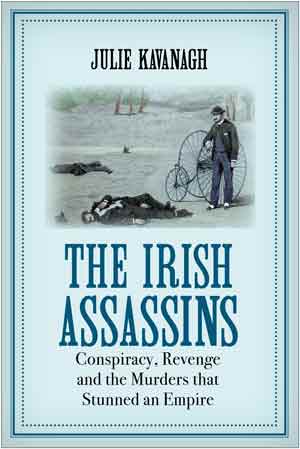THE IRISH ASSASSINS: conspiracy, revenge, and the Phoenix Park Murders that stunned Victorian England
Published in Book Reviews, Book Reviews, Issue 4 (July/August 2022), Reviews, Volume 30JULIE KAVANAGH
Grove Press
£18.99
ISBN 9781611856415
Reviewed by Barry Walsh
Barry Walsh is a solicitor and a former Policy Adviser at the Department of An Taoiseach.
The final decades of British rule in Ireland have been examined by many British authors in the last century, often with mixed results. The works of Charles Townshend, for example, have been rightly praised on this side of the Irish Sea, while those of Lord Longford have deservedly received a more hostile reception.
Julie Kavanagh makes an unlikely addition to this list. A former London editor of The New Yorker and Vanity Fair, her previous books include biographies of the ballet dancer Rudolf Nureyev and the French courtesan Marie Duplessis, the inspiration for Verdi’s La Traviata. Her admission that the politics of Victorian Ireland is ‘a subject far beyond my comfort zone’ seems like a considerable understatement. And yet Kavanagh displays an excellent grasp of the complexities of the period. This book is a triumph, and one of the best I have read in quite some time.
The Phoenix Park Murders are familiar to anyone who managed to get as far as Leaving Cert history. The brutal assassination on 6 May 1882 of Lord Frederick Cavendish and Thomas Henry Burke, respectively the chief secretary to Ireland and the under-secretary at Dublin Castle, was probably the single greatest hammer blow to British authority in Ireland in the nineteenth century. Two of the three most powerful political office-holders in Ireland were cut down in one fell swoop. Carried out by the ‘Irish Invincibles’, an extreme fringe of the Irish Republican Brotherhood, and funded by American supporters, the crime had dire short-term consequences for Parnell’s growing alliance with Gladstone’s Liberals. They reared their ugly heads again in 1891 during the ‘Pigott forgeries’ affair, when Parnell was falsely accused of involvement in the conspiracy. But for most students of Irish history this is where knowledge of the murders begins and ends—just one of many land-mines along the road to Home Rule.
The only other modern examination of the assassinations that I am aware of is The Phoenix Park Murders: conspiracy, betrayal and retribution (2006) by the journalist Senan Moloney, an engaging work that is somewhat hamstrung by its reliance on contemporary newspaper reports. Julie Kavanagh has built on this in brilliant fashion.
Continuing research begun by her late father, she details the planning and execution of the murders, together with the investigation, trial and aftermath. She shows how the crimes caused ripples in the United States and South Africa, and tidal waves in Ireland and Britain. Her narrative centres around six individuals: three women—Lucy Cavendish, widow of Lord Frederick and a niece and virtually surrogate daughter of Gladstone; Katherine O’Shea, Parnell’s long-time partner and later wife; and Queen Victoria—and three men—Patrick Mallon, the lead detective investigating the crimes; James Carey, the ringleader of the plot turned informer; and Patrick O’Donnell, who shot Carey while he was fleeing to South Africa, an episode that was the subject of a recent TG4 docu-drama, ‘The Queen v Patrick O’Donnell’.
Kavanagh appears to have engaged in a truly dizzying amount of new and original research over a period of five years. Of particular novelty for an Irish reader is her examination of the reactions of Lucy Cavendish and the extended Gladstone family through their private papers and those of their immediate associates. At times, Lucy comes across almost as a protagonist in a Jane Austen novel, with Kavanagh candidly remarking that her correspondences display a ‘saintliness that verges on the cloying’. Nevertheless, her devotion to her husband, her capacity for forgiveness following his death, and the close bond she had with Gladstone all ring true here.
Kavanagh details several important finds made during her research. At the Royal Archives at Windsor she discovered the ‘horrified, scrawled response’ written by Queen Victoria upon receiving word of the murders. At the UK National Archives in Kew she unearthed two notes written by the jury foreman at O’Donnell’s trial in 1883, which suggest that the trial judge had placed his thumb on the scales of justice to O’Donnell’s disadvantage.
The book’s only weakness stems from what is also, in many ways, its greatest strength. Written in a highly engaging style, in the ‘episodic structure of today’s television dramas’, as the author puts it, this book sometimes feels like a historical novel or a work of true crime. This, however, limits the scope for critical analysis, sometimes leading the author to be overly generous to her various subjects and to accept hastily certain factual conclusions.
One early example is her mention of the death of a prison officer during the 1867 break-out attempt involving the ‘Manchester Martyrs’, which Kavanagh says was ‘just an accident’, baldly accepting the defence raised by the three men. This raid was pre-planned and heavily armed, and a shot was deliberately fired into a prison van. To accept that the resulting death was an ‘accident’ is something of a stretch. However, the pace and sheer readability of the book more than compensate for such narrative quibbles. Julie Kavanagh has shown that a great deal remains to be written about this period. This is a book that deserves to be read widely.

















